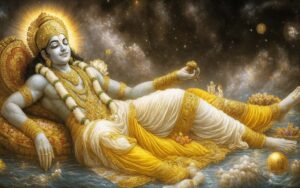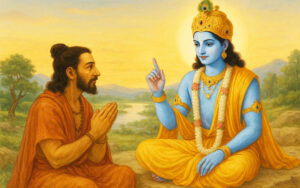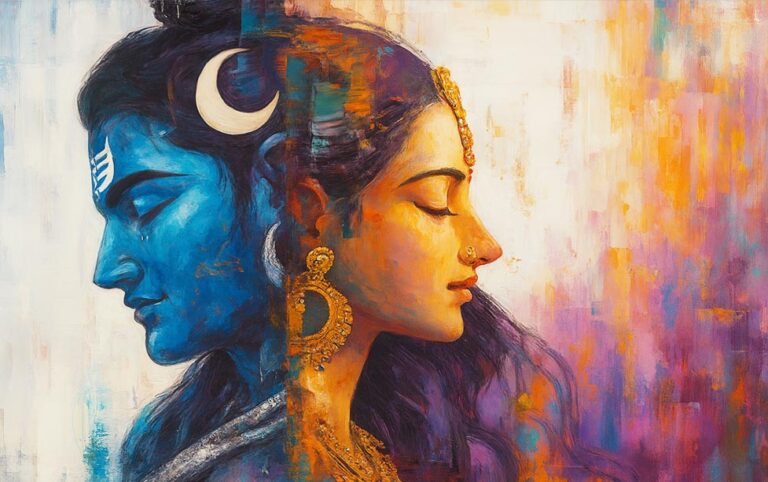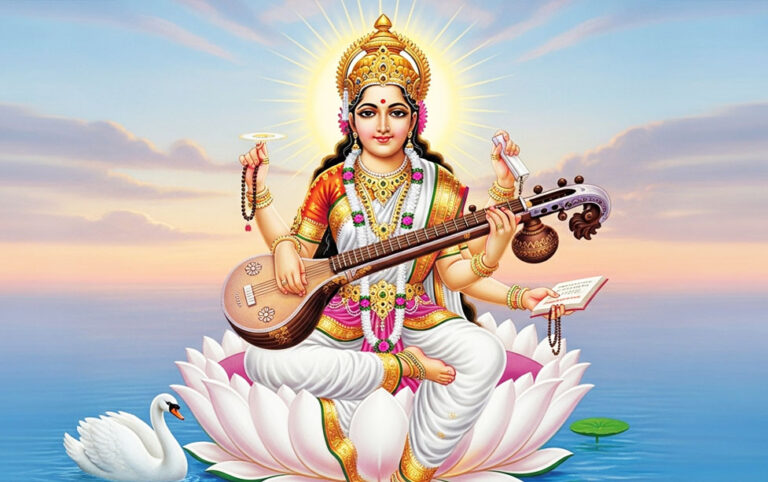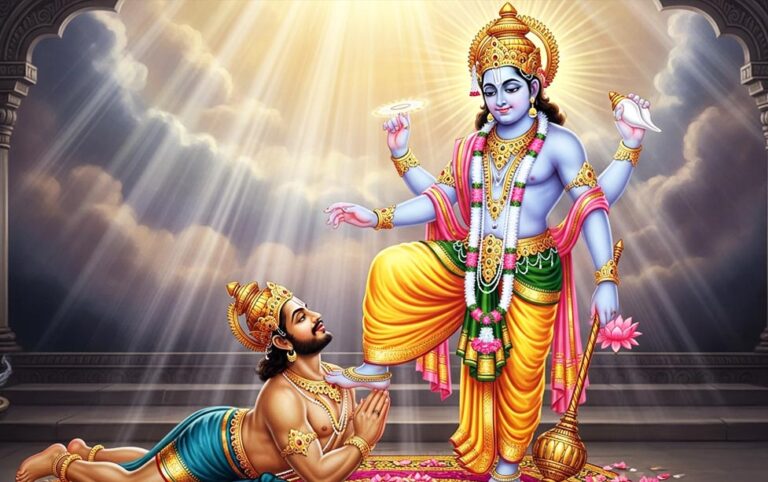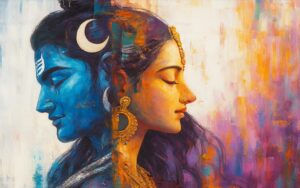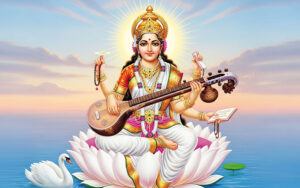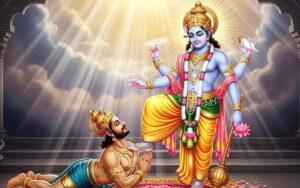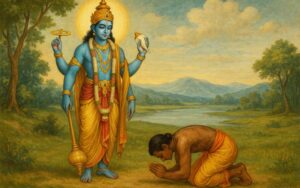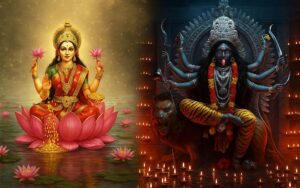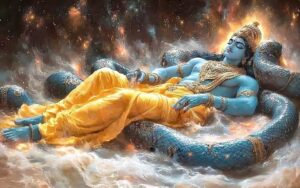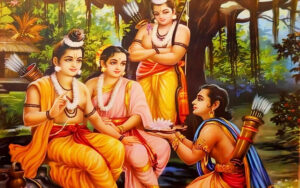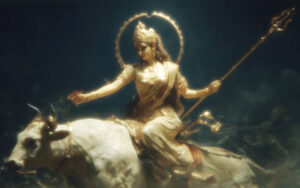
No time for reading the story? Give it a listen on Spotify.

This is the divine story of how Radha’s transcendental love and longing for Krishna led to the creation of the sacred land of Navadvipa.
Characters in the story:
Radha: Radha, also called Radhika and Radharani, is a Hindu goddess and the chief consort of Krishna. She is the goddess of love, tenderness, compassion, and devotion. She is the feminine counterpart and internal potency (hladini shakti) of Krishna.
![]()
Lord Krishna: Lord Krishna is one of the most popular and revered deities in Hinduism. He is worshipped as the eighth avataar of Lord Vishnu and is known for his divine teachings in the Bhagavad Gita and for his role in the epic Mahabharata.
Author’s Note: This story draws reference from the Ananta Samhita, authored by Ananta Vasudeva, a disciple of Srila Bhaktisiddhanta Sarasvati Thakur. It is a scripture within the Gaudiya Vaishnava tradition. It should be noted that the original Puranas do not mention Radha. The first reference to Radha appears in the epic poem Gita Govinda, composed by Jayadeva in the 12th century AD. Later references to Radha were incorporated into subsequent versions of the Bhagavatam or Bhagavata Purana, influenced by the teachings of Chaitanya Mahaprabhu around 500 years ago.
In the sacred text Ananta Samhita, Lord Shiva shares a celestial secret with Parvati—a tender and divine episode from the eternal pastimes of Lord Krishna.
Krishna’s Playful Pastime and Radha’s Sacred Jealousy
One day, Krishna was engaged in exchanges with a gopi named Viraja in a secluded grove in Vrindavan. Word of this moment reached Radha through one of her sakhis (confidantes). On hearing this, Radha—her face radiant like the moon—was filled not with ordinary jealousy, but a transcendental longing rooted in pure devotion.
Unlike worldly jealousy, which is driven by ego and possession, Radha’s divine emotion sprang from her unmatched desire to serve Krishna in the deepest, most loving way. She knew no one could bring joy to Krishna the way she could. Moved by this sacred emotion, she hastened to the grove.
The Disappearance and a River’s Birth
Krishna, sensing Radha’s arrival, immediately disappeared to preserve the sanctity of her emotions. At the same time, Viraja, in a gesture of reverence, transformed herself into a river that flowed around the bounds of Vrindavan. When Radha arrived, she found neither Krishna nor Viraja.
Radha Creates a Divine Realm
Determined to win Krishna’s attention through devotion rather than emotion, Radha used her yogamaya shakti—her spiritual power—to manifest a realm of unmatched beauty. Between the Ganges and Yamuna rivers, she created a splendid divine abode: fragrant with jasmine, malati, and madhavi flowers; alive with deer, peacocks, and fluttering butterflies; and enchanted with the sweet calls of birds.
She called upon Kamadeva (Cupid) and the spirit of eternal spring to make this land their home, ensuring it would always remain fresh and enticing for Krishna’s pleasure. She also instructed the birds to forever sing Krishna’s holy names, making the air itself resonant with divine love.
Krishna Arrives and Navadvipa is Named
Drawn by the irresistible melody Radha played on a flute, Krishna appeared, smiling, and took her hand. With great affection, He said,
“O lotus-faced Radha, you are my very life. No one is dearer to me than you.”
Moved by the beauty of the place Radha had created, Krishna proclaimed:
“This enchanting land, nestled between two rivers, shall be called Navadvipa—the nine islands. From today, all holy places will reside here. Any devotee who worships us here will attain the mood of your sakhis. And even a single visit to this dham will bless them with the fruit of visiting all sacred places.”
(Author’s Note: While the exact location of Navadvipa is not confirmed in the Puranic scriptures, later texts from the Gaudiya Vaishnava tradition identify Navadvipa—also known as Navadvipa-Mayapur—as being in the present-day state of West Bengal, India. It is said to comprise nine islands arranged in the shape of a lotus flower. These nine islands are: Antardvipa, Simantadvipa, Godrumadvipa, Madhyadvipa, Koladvipa, Ritudvipa, Jahnudvipa, Modadrumadvipa, and Rudradvipa. The region is considered sacred, particularly as the birthplace of Sri Chaitanya Mahaprabhu.)
Eternal Teachings from the Pastime
Selfless Love: Radha’s transcendental jealousy reveals the highest form of love—not for possession, but for giving joy to the beloved.
Devotion as Creative Power: Her ability to manifest an entire divine realm shows the boundless potential of pure devotion.
Sacredness of Navadvipa: This pastime declares Navadvipa as not just a geographical place, but a heart-space of divine love, eternally vibrant with the mood of madhurya rasa (sweet devotion).
From the Scriptures
“tad-aśma-sāraṁ hṛdayaṁ batedaṁ yad gṛhyamāṇair harināma-dheyaiḥ
na vikriyetātha yadā vikāro netre jalaṁ gātra-ruheṣu harṣaḥ”
— Śrīmad Bhāgavatam 2.3.24
“Surely the heart that does not melt, even when the holy names of Hari are chanted with devotion—showing no tears, no hair standing on end—is made of stone.”
This verse mirrors Radha’s own devotional ecstasy, which manifested not just in emotion, but in the creation of an eternal dham—Navadvipa—a place where the divine name, divine love, and divine joy eternally dwell.
Thus, through Radha’s pure devotion, a new divine abode—Navadvipa—was born, echoing eternal love and spiritual bliss. Even today, it remains a sacred refuge where devotees can taste the sweetness of divine union.


